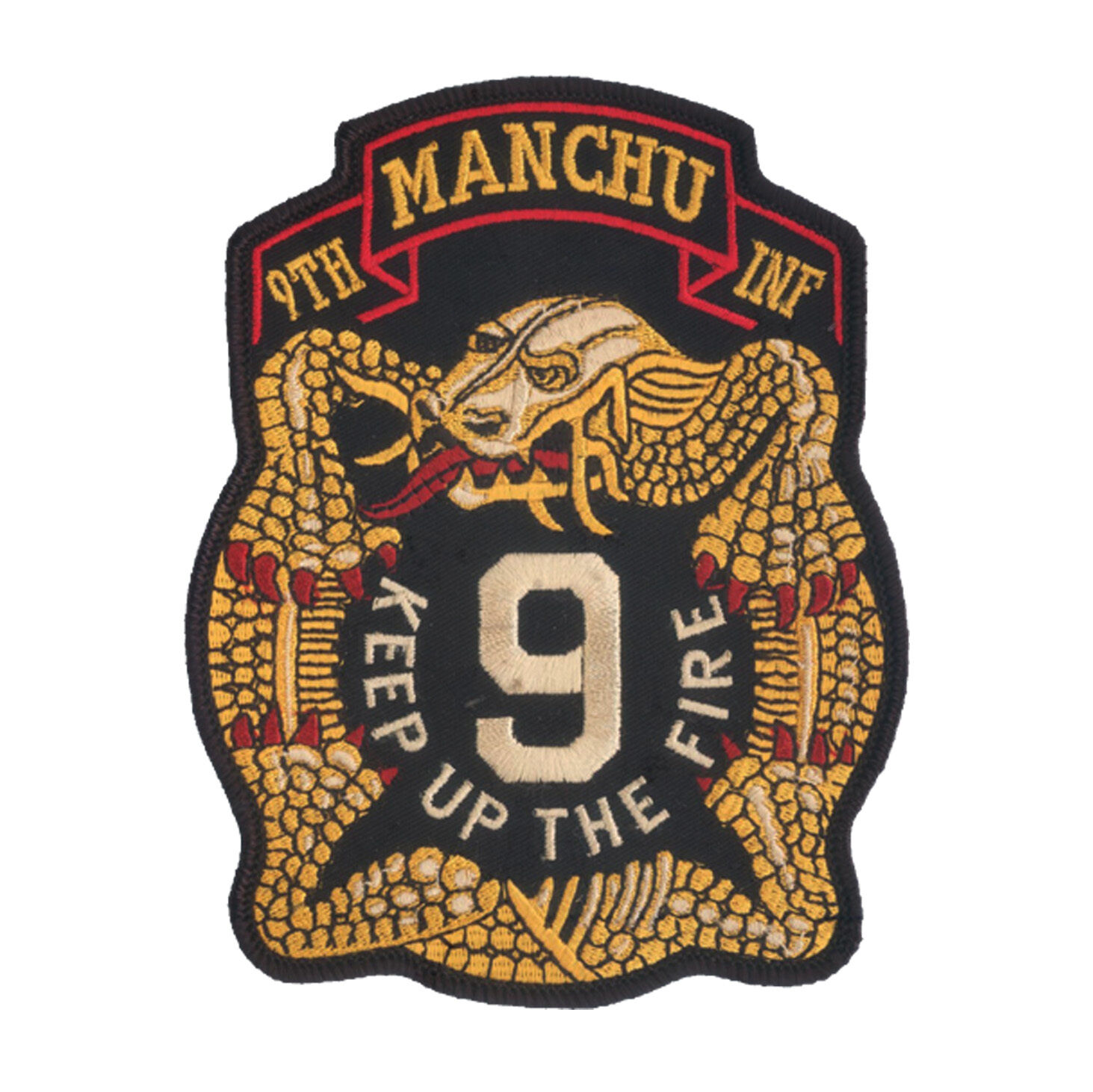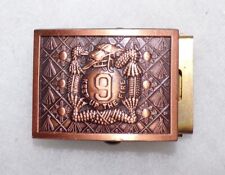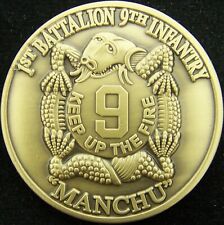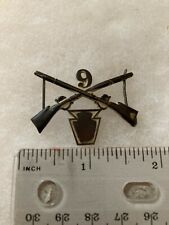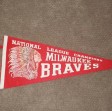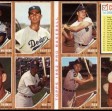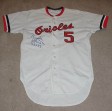When you click on links to various merchants on this site and make a purchase, this can result in this site earning a commission. Affiliate programs and affiliations include, but are not limited to, the eBay Partner Network.
Jungle Expert PatchMOTORCYCLE -9th INFANTRY REGIMENT - MANCHUS
11 1/4" X 10" HIGHLY DETAILED EMBROIDERED PATCH
US ARMY MORALE PATCH - MERROWED EDGE
WAX BACKINGUS ARMYMANCHU - MORALE PATCH - MOTORCYCLE PATCH - IE SUZUKI, YAMAHA, HARLEY DAVIDSON, TRIUMPH,INDIAN, BSA, VICTORY, ETC.MORALE PATCH - BIKER PATCH - MOTORCYCLE PATCH - 9TH INFANTRY
History
The 9th Infantry Regiment is one of the firstunits authorized in the United States Army. It first appeared as aresult of the Act of 16 July 1798, that authorized twelve additionalregiments of infantry, in January 1799. Josiah Carville Hall, ofMaryland, was its Lieutenant Colonel. All of the officers were appointedfrom Maryland, and the regiment was recruited in that state. However itwas disbanded 15 June 1800. It appeared again serving in the War of1812, it was again organized in March 1812, with Simon Learned, ofMassachusetts, as colonel. The regiment was raised in Massachusetts, andtook part in the War on the northern border, being present at the Battleof Lundy's Lane, and other actions in that area. Following the war inthe reorganization of the army, this regiment was again disbanded.
As a result of the Mexican-American War, inApril 1847, the 9th Infantry was again organized, as one of the ten oneyear regiments authorized by the Act of 11 February 1847. It was brieflycommanded by Franklin Pierce before Pierce was promoted to brigadiergeneral and commander of the brigade that included the 9th Regiment.Pierce was succeeded by Colonel Truman B. Ransom, who was killed in theassault upon Chapultepec Castle. He was succeeded by Col. Jones M.Withers, who resigned 23 May 1848, and he was succeeded by Col. Henry L.Webb. The regiment served in the Mexico City campaign and was in theBattle of Contreras, Battle of Churubusco, Battle of Molino del Rey andat the Battle of Chapultepec where it took a distinguished part. At theBattle of Chapultepec it was in support of the storming force, butjoined with it as a part of the assault on the citadel. Sixteen officersand eleven enlisted men of the regiment were mentioned by name in thereport of Major General Gideon Pillow for meritorious conduct in thisbattle, among the former being second lieutenant R. C. Drum, later aGeneral. In August 1848, the regiment was again disbanded.
Oregon and Washington Territory Indian Wars
Between March and November 1855, the 9thInfantry Regiment was again organized under Colonel George Wright atFortress Monroe, Virginia. It has remained in continuous existence sincethen. Silas Casey was its Lieutenant-colonel, and Edward Steptoe, andRobert S. Garnett were its Majors. In December 1855 the regiment wasordered to the Pacific Coast, via Panama, arriving in the latter part ofJanuary 1856. The headquarters and Companies A, B, C, E, F, G, I and K,took station at Fort Vancouver, Washington Territory. Lieutenant-ColonelCasey with Companies D and H going to Fort Steilacoom, and was plungedinto operations against the Nisqually, Muckleshoot, Puyallup, andKlickitat in the Puget Sound War.
From March 1856, Colonel Wright withcompanies from Fort Vancouver were fighting the Yakima War. Followingthe close of field operations until the spring of 1858, the regiment wasengaged in building posts and making roads. In August 1857, Company Fwas detailed as escort to the Northern Boundary Commission and remainedin the field on that duty nearly three years.
In 1858, during part of the wars with NativeAmericans in the West, the 9th was posted at Fort Dalles in OregonTerritory under the command of then Colonel George Wright. In May 1858,Company E under Major Steptoe formed part of a force of one hundred andfifty-nine men sent to make a reconnaissance of the country to the northof Fort Walla Walla. On 17 May 1858, Steptoe's command was attacked byover one thousand Indians in the Battle of Pine Creek which triggeredthe Spokane – Coeur d'Alene – Paloos War. In August 1858, an expeditionfrom Fort Dalles under Colonel Wright proceed against the SpokaneIndians and their allies. The following Battle of Four Lakes broughtabout a lasting peace with the Indians eastern Washington.
In October 1860, Captain Frederick Tracy Dentwith Company B and a detachment of Company E, left Fort Walla Walla, torescue the emigrants who had escaped from the Salmon Falls Massacre, onthe Snake River. In May 1861, a detachment of the regiment was detailedas an escort to the Fort Benton wagon road expedition, for nearlyfifteen months.
Civil War and late 19th CenturyIndian Wars
During the American Civil War the 9thInfantry Regiment, was ordered to San Francisco prior to its transfer tothe East. Its Colonel Wright was promoted to command of the Departmentof the Pacific, and the order was revoked. The regiment was left on thePacific Coast where it had duty at the posts near San Francisco,performing provost guard duty in that city until late in 1865. Followingthe death of Colonel Wright in the wreck of the steamer BrotherJonathan, Colonel John H. King succeeded to command of the 9th Regimentin December 1866.
During the period from 1866 to 1869, elementsof the regiment were in the Snake War in Northern California and Oregonand in conflict with the Chemehuevi in Southern California. In June1869, the regiment was ordered to the Department of the Platte, where itabsorbed the 27th Infantry Regiment. It was from the 27th InfantryRegiment that the regiment gets its Civil War battle honors, derivedfrom the 2nd Battalion of the 18th Infantry Regiment that was the cadrearound which the 27th formed at the end of the Civil War.
Following the reorganization the 9th Infantryperformed garrison duty at various posts and guard duty on the UnionPacific Railroad line. In May 1873, six companies, A, D, E, F, H and I,were sent to the Department of Dakota for duty with the YellowstoneExpedition, escorting the engineers locating the Northern PacificRailroad. From the summer of 1874 to May 1876, the regiment wasstationed at posts on or near the Sioux reservation in Nebraska andWyoming and was almost constantly escorting wagon trains. In the summerof 1875 Companies C, E and H, were in the Black Hills, Dakota, as partof the escort to the Newton–Jenney Party, Company E remained in thefield until November assisting in ejecting white intruders who hadentered Sioux territory.
In May 1876, Companies C, G and H became apart of the Big Horn and Yellowstone Expedition under command ofBrigadier General Crook and were in the field until late in Octobertaking part in the engagement with the Indians at Tongue River, Montana,9 June, the Battle of the Rosebud, and the Battle of Slim Buttes.Companies G and H also assisted in repelling a night attack by Indianson the camp on Goose Creek, Wyoming, 9 July 1876. In the early part ofSeptember the entire command was without rations for a number of days,and subsisted on horse flesh and a small quantity of dried meat andfruit captured at Slim Buttes. In October, 1876, the Powder RiverExpedition was organized and Companies A, B, D, F, I and K formed a partof it. They remained in the field until January 1877, during the mostsevere part of the winter, and practically brought to a termination theGreat Sioux War of 1876–77.
In July 1877, Companies B, D, F, H, I and Kwere a part of the force sent to Chicago, Illinois, at the time of theGreat Railroad Strike of 1877. They remained a month performing guardduty over various public and private institutions.
During the summer and fall of 1878 CompaniesB, C, H and I were a part of a force of observation on the LittleMissouri River, and in the northwestern part of the Black Hills.
In October 1878 Companies G and K were partof the force in the field in the Cheyenne War. Company K was mounted andtook active part in the pursuit.
In October, 1879, Companies E and K went intothe field in the White River War, remaining until July 1880.
In 1883, Col. John S. Mason, took command ofthe 9th Regiment and in July 1886, the regiment went to the Departmentof Arizona. During their service there the regiment was in garrisons atevery post in Arizona and at some posts in New Mexico. Four companies,C, E, H and I, were in the field in New Mexico for about a month duringthe Apache campaign of 1886 against Geronimo.
Following the end of the Indian Wars theregiment participated in the Spanish-American War.
20th century
Boxer Rebellion
At the beginning of the century the U.S. Armydispatched the 9th Infantry Regiment to Qing China during the BoxerRebellion and the China Relief Expedition where the regiment earned thenickname "Manchus". During the Battle of Tientsin, three 9th Regimentsoldiers won the Medal of Honor and the regimental commander, Col.Emerson H. Liscum, was killed by Chinese fire, as was the flag bearerfor the regiment. A Chinese sniper shot Liscum as he tried to steady theflag after the bearer was killed. The Chinese again unleashed a torrentof fire upon the Allies, which forced them to lie face down in mud. Thedark blue uniform of the American troops provided a virtual bull's eyeto the Chinese troops, equipped with western firearms, such asWinchesters, Mausers, and Mannlichers. Many American troops died fromChinese sniper fire before they took the city. The regiment suffered aten percent casualty rate in the battle. Colonel Liscum's dying wordsgave the regiment its motto, "Keep up the Fire." Lt. Col. Charles A.Coolidge assumed command, the Allies then captured the city, and theregiment was awarded two silver ingots from which the Liscum Bowl wascreated. The regiment fought in the Battle of Yangcun.
Philippines
Following duty in China the regiment servedin the Philippine-American War and was involved in the Balangigamassacre.
WWI
In early October 1917, the Manchus deployedto France as part of the "Indianhead" 2nd Infantry Division. During thecourse of the war, 9th infantrymen earned battle streamers for theircolors at Lorraine, He de France, Aisne-Marne, and St. Mihiel. In 1918,the Manchu Regiment received the French Fourragère for gallantry duringthe Meuse-Argonne offensive.
WWII
The Manchus returned to Europe and combataction during World War II. After breaking out from the beachhead atNormandy, the Manchus waged an 18-hour engagement during the Battle ofthe Bulge. With the Allied line established, the 9th spearheaded a 1945drive toward the Siegfried Line. The Manchus crossed the Rhine in March1945 and advanced rapidly through Saxony into Czechoslovakia, ending thewar with many decorations including three Presidential Unit Citations.
Korea
When South Korea was invaded in 1950 theManchus returned to the far east and the Korean Peninsula. Manchu troopswere the first of the 2nd Infantry Division to touch Korean soil. Theywere successful at Bloody Ridge, Heartbreak Ridge, Old Baldy, Pork ChopHill, and T-Bone Hill. During the Korean War, the regiment earned anadditional Presidential Unit Citation for its gallant service atHongchon, and six of its members received the Medal of Honor: Loren R.Kaufman (4 and 5 September 1950), Edward C. Krzyzowski (31 August to 3September 1951), Joseph R. Ouellette (31 August to 3 September 1951),David M. Smith (1 September 1950), Luther H. Story (1 September 1950)and Travis E. Watkins (31 August to 3 September 1950).
Vietnam War
On 14 January 1966, the 4th Battalion, 9thInfantry Regiment, was relieved from assignment to the 171st InfantryBrigade and assigned to the 25th Infantry Division "Tropic Lightning" atSchofield Barracks, Hawaii. A month earlier these Manchus had been inAlaska preparing for annual winter maneuvers to be conducted intemperatures of 50 below zero. Eight weeks later the battalion waspreparing for deployment to the heat and humidity of South Vietnam.
On 29 April, the battalion disembarked theship General Walker at Vung Tàu, Vietnam. Within hours of their arrivalthey found themselves under fire as their convoy made its way to the25th Division's C? Chi Base Camp. The next day, a little more than 24hours after arriving in country, Alpha company engaged the enemy in afirefight – setting the tone of regular contact that would characterizethe Manchu experience for the next four and a half years.
Many operations were conducted bycompany-sized or smaller units but there were also notable larger scaleoperations in which the entire battalion took part. They includedAsheville, Wahiawa, Joliet I and II, Helemano, and Kahana I and II.
On 22 February 1968 the Manchus closed thebase at Katum which had served as the large forward base for the 1st BDEnear the Cambodian border. After a day at Tây Ninh Combat Base toprepare, the Manchus moved out to C? Chi and eventually arrived north ofTan Son Nhut on 25 February. The mission was to find and destroy rocketsites that had been used to fire on Tan Son Nhut Air Base since the TetOffensive began nearly a month earlier. At 9:00 AM on 2 March 1968, theManchus walked into what was to become one of the worst single-encounterloss of life incidents in the history of the Vietnam war. Forty-ninemembers of Charlie Company were killed and 24 wounded in an ambush by alarge communist force on Route 248 north and east of Tan Son Nhut nearthe small village of Quoi Xuan. In addition, C Company suffered 24wounded while D Company suffered casualties in the fighting to reachCharlie Company. SP4 Nicholas J. Cutinha would be posthumously awardedthe Medal of Honor for his actions at Quoi Xuan. Manchu Alpha, Bravo,and Delta continued operations in this area and took many morecasualties until finally leaving on 11 March 1968. Rocket sites had beendestroyed, and a formidable communist force had been weakened, if notdestroyed. But, it had come at a great cost to the Manchus andparticularly Charlie Company.
In the four years and six months of servicein Vietnam with the 25th Division, the 4th Battalion of the Manchusreceived two Presidential Citations and added 12 campaign streamers toregimental colors for combat operations in the Republic of Vietnam(South Vietnam). It is estimated that 450 4th Battalion Manchus werekilled in the Vietnam War.
Three Manchus were posthumous recipients ofthe Medal of Honor, the United States' highest award for valor: NicholasJ. Cutinha, Ruppert L. Sargent and Maximo Yabes.
1970s
After its service in the Vietnam war, theregiment was transferred back to the United States and was stationed inAlaska. During the Vietnam War, the 6th battalion of the 9th InfantryRegiment was assigned to the 171st Infantry Brigade at Fort Wainwright,Alaska. The majority of the unit's training was in light infantry winteroperations. The training consisted of developing cold weather operationsand mountaineering skills. Modes of transportation included using skisor snowshoes and pulling equipment on Ahkio sleds; helicopters; or AirForce transport aircraft. Company C, 6th Battalion was an Airborne unit,and was the first of the "Charlie Airborne" companies stationed inAlaska. Summer training was primarily adventurous in nature, andincluded encampments at primitive locations within the state. The 6thBattalion was also a regular participant in the annual 'Alaska Days'parade in Sitka. The 9th Infantry Regiment was included in this eventbecause it was stationed in Sitka when the Alaska Purchase wasfinalized, and Alaska was turned over to the United States by ImperialRussia. In 1972, the 6th Battalion was inactivated, and its Soldiers andequipment were used to reactivate the 4th Battalion, 9th InfantryRegiment. The 4th Battalion was assigned to the 172nd Infantry Brigadeat Fort Richardson, but remained stationed at Fort Wainwright, and itsCompany C was retained on airborne status.
In the summer of 1975, the inactive 2ndBattalion was activated and assigned to the 1st Brigade, 2nd InfantryDivision, at Camp Casey, Republic of Korea (South Korea). In March 1976,the 2nd Battalion moved to Camp Greaves near the DMZ, with A Companymanning Camp Liberty Bell. Missions there included reconnaissancepatrols within the DMZ; manning Guard Posts Collier and Oulette, bothlocated within the DMZ and supporting the United Nations Command JointSecurity Force at Camp Kitty Hawk; securing Freedom Bridge, spanning theroute south from Panmunjom across the Imjim river; and manning a smallsector of the southern boundary fence of the DMZ. (Camp Kitty Hawk waslater renamed Camp Bonifas in memory of Captain Arthur Bonifas, who wasmurdered along with Lieutenant Mark Barrett by North Korean troopsduring the Axe Murder Incident, which resulted in Operation_Paul_Bunyanbeing conducted by the United States Army.)
In late 1978, the 2nd Battalion was relievedof duty on the DMZ by its sister 1st Battalion, 9th Infantry Regiment.The 1st Battalion had been stationed at Camp Hovey and Camp Liberty bell
was commanded by LTC Clinton Fields. The 1stBattalion continued the mission to man Guard Posts Oulette and Collier,conduct combat and recon patrols, man the southern entrance to the DMZand maintain the bridge platoon that guarded Freedom Bridge. LTC ClintonFields relinquished command of the 1st Battaion to LTC Michael D.Collins soon after the move from Camp Hovey to Camp Greaves.
1980s and 1990s
Early in 1989, the Manchus deployed to Panamaas part of a show-of-force Operation Nimrod Dancer along with other U.S.forces. The 9th was based out of Fort Sherman. Units of the 9thconducted route reconnaissance and security patrols between FortsSherman and Espinar on the other side of the Panama Canal. The 9th wasfully re-deployed by the end of November 1989 and returned less than amonth later for the U.S. invasion. During Operation Just Cause inDecember 1989, the Manchus were called upon again. Infantrymen from the1st, 2nd, and 3rd Battalions earned the Combat Infantryman Badge (CIB)for the first time since Korea. Initially DOD awarded the CIB to allsoldiers who took part in Just Cause, but subsequently rescinded theawards after closer review of regulations found that the CIB could onlybe awarded to 11-series MOS (infantry) soldiers. This led to an attemptby a number of 1st Battalion infantrymen to return their CIBs insolidarity with the combat medics, air defenders, and others who had totake up the rifle and engage in the same house to house and junglefighting as the infantry.
Panama was the last conflict fought by theManchus under the 7th Infantry Division (Light). During both operations,the regimental commander was Colonel David R.E. Hale. One of Hale's keycommanders in Panama, Lt. Col. Chuck Swannack went on to become a majorgeneral and commander of the 82nd Airborne Division in Iraq from 2002 to2004. Another key officer was Lt. Col. William J. "Bill" Leszczynski,Jr., who later commanded the 75th Ranger Regiment and was promoted tobrigadier general. Hale himself became a major general, but was forcedinto retirement because of personal misconduct of a sexual nature. Halewas subsequently court-martialed in 1999 and reduced in rank (forretired pay purposes) to brigadier general.
The 1st, 2nd, and Regimental Headquarters(along with the Regimental Treasure, including the Liscum Bowl) werereassigned to Ft. Lewis, WA in late 1993, after the closure of Ft. Ord,which had been the home of the 7th ID (and consequently the 9thRegiment) prior to 1993. The unit moved into the barracks near the 75thRanger Battalion, adjacent to Grey Army Airfield on the main post of Ft.Lewis. One of the last cohort units of basic training recruits (B Co,38th ID, Ft. Benning) which were initially assigned to the 7th ID, Ft.Ord, were subsequently either reassigned to other mechanized units orreassigned to the 9th in Ft. Lewis just prior to graduation and werequickly integrated into the 9th once they reported for duty there. The1st and 2nd Battalions of the 9th continued to serve from Ft. Lewis forthe next two years, before being reassigned to the 25th InfantryDivision.
The 4th and 5th Battalions, 9th InfantryRegiment were activated back at Fort Wainwright, Alaska in 1986. Theywere assigned to the 1st Brigade of the 6th Infantry Division (ArcticLight) and were specially trained in Arctic warfare. The 5th Battalionwas reflagged 1st Battalion, 17th Infantry Regiment in 1994 and the 4thBattalion was reflagged 2nd Battalion, 1st Infantry Regiment in 1995.These renamings occurred prior to the brigade being redesignated as the172nd Infantry Brigade and the division being deactivated.
In January 1995, the 1st Battalion, 9thInfantry Regiment, along with augmentation from the 79th Forward SupportBattalion, 2nd Battalion, 8th Field Artillery (Automatic), and the 13thEngineer Company, deployed from Fort Lewis, WA to Guantanamo Bay, Cubain support of Operation Sea Signal where they provided transportationand security for Cuban and Haitian immigrants awaiting movement to theUnited States by supporting camps Echo, Foxtrot, and Golf. The 1st ofthe 9th, known as Task Force 1st Manchu, returned to Fort Lewis, WA inJune 1995. August 1995 the 1st Brigade, 7th Infantry Division (sometimeserroneously referred to as the 9th Regimental Combat Team, although RCTshave not existed in Army force structure since the late 1950s), whichincluded the battalions of the 9th Infantry at Fort Lewis, WA, wasreflagged as the 1st Brigade, 25th Infantry Division and the Manchu nameand colors returned to the 2nd Infantry Division stationed in Korea. Thereflagging ceremony took place on I Corps' parade grounds and included a"Drink the Fire" ceremony, during which all assigned Manchu soldiersdrank a toast from the Liscum Bowl.
The 1st and 2nd Battalions of the 9thInfantry Regiment returned to Korea in September 1995 (i.e. unitsalready deployed in Korea were redesignated as the 1st and 2ndBattalions).
21st century
First Battalion of the 9th Infantry Regimentrecently returned from a tour in Iraq, serving in Operation IraqiFreedom I and II from August 2004 to July 2005 and subsequently based atFort Carson, Colorado, as part of the 2nd Brigade Combat Team of theSecond Infantry Division. In November 2005, the First Battalion of the9th Infantry Regiment had the majority of their personnel transferred tothe newly activated 3rd Squadron of the 61st Cavalry Regiment as part ofthe 2nd Brigade Combat Team, 2nd Infantry Division. At the same time,the Unit Colors of the 1st Battalion, 503rd Infantry (also a part of the2nd Brigade Combat Team at the time) was transferred to Vicenza, Italyto be stationed with the 173rd Infantry Brigade (Airborne), thepersonnel remaining at Fort Carson, Colorado were transferred to the 1stBattalion, 9th Infantry. The battalion deployed with 2nd Brigade CombatTeam in support of Operation Iraqi Freedom 06-08 to Ramadi, successfullydefeated the insurgency during Operation Murfreesboro. Upon redeploymentto Fort Carson, the brigade reflagged to 4th Brigade Combat Team of the4th Infantry Division, and the battalion reflagged to 1st Battalion,12th Infantry Regiment.
The Second Battalion of the 9th InfantryRegiment is still active today and is part of the 1st Brigade of the 2ndInfantry Division, which is currently based in South Korea. The SecondBattalion has a twice a year tradition called the "Manchu Mile", whichinvolves its members marching 25 miles (40.2 km) in full combat gearacross Korea's mountainous terrain. This is to commemorate an 85 mileforced march performed by the unit during the Boxer Rebellion.
The Third Battalion of the 9th InfantryRegiment is not active at this time.
The Fourth Battalion of the 9th InfantryRegiment was re-activated on 1 June 2006 and is assigned to the newlydesignated 4th Brigade Combat Team, 2nd Infantry Division, based atJoint Base Lewis-McChord, Washington. As the 4th Brigade is a StrykerBrigade Combat Team, this battalion of the 9th Infantry Regiment is nowa fully mobile mechanized infantry unit. The battalion deployed to Iraqin the spring of 2007 and engaged in combat operations in Tarmiyah, theBattle of Baqubah, and other locations throughout Diyala and SalahEd-Din. At the same time they field tested the Army's Land Warrior nextgeneration soldier technology.
The Fourth Battalion returned from Iraq inthe fall of 2010 during the last days of Operation Iraqi Freedom.
COAT OF ARMS
OF THE 9TH INFANTRY REGIMENT
The Regimental Coat of Arms is commemorativeof the varied exploits of the Regiment and vividly illustrates many ofits campaigns. The foundation for the symbol is a blue shield, with theemphasis on distinguishing the unit branch of Infantry. Service in Chinaduring the Boxer Rebellion is symbolized in the golden dragon insertedon the upper left of the shield. In the upper right sector is implantedthe Sun in Splendor, a device used by the Filipino Insurrectos, whichserves as a reminder of service in the Philippines. The light shaded barcurved toward the upper portion of the shield stands as a mute memorialof the battle on the bend of the San Juan River, or the "Bloody Angle."The active years on the Western Frontier, during the Indian Wars, arecharacterized in the "Teepee," centered in the lower half of the shield.The Indianhead patch placed above the body of the shield designates theassignment of the Manchu Regiment to the Second Infantry Division inOctober 1917, while the Fourragere, in the colors of the ribbon of theFrench Croix de Guerre, encircling the lndianhead is a memorial to thevaliant exploits of World War 1. Beneath the shield is a scroll on whichis engraved a living motto and challenge to the members of the ManchuRegiment to "Keep Up The Fire."
History of the Liscum Bowl
One of the foremost trophies of any Americanregiment is the Liscum Bowl, tresured by the 9th United States Infantry.It stands as a monument to Colonel Liscum, regimental commander, who waskilled in action at Tientsin, China, on 13 July 1900.
The background of the bowl lies in theAmerican Relief Expedition to China. On 13 July 1900, shortly afterarriving on Chinese shores, the regiment was engages in the conquest ofthe walled city of Tientsin. With the exception of a battalion ofMarines, the 9th Infantry was the only American unit engaged in thestruggle, or in the locale. In the course of an assault upon the wallsof Tientsin, Col. Liscum was struck by Chinese fire, and shortly afterdirecting his men to "Keep up the Fire" on the walls of the city, hedied.
When Tientsin fell, it was divided intodistricts, each of which was occupied by one of the various nationsengaged in the expedition. Portions of the city were in flames, andofficial seizures, together with private looting, were occurringperiodiclly. Two days after the fall, on 15 July, a goverment mint wasdiscovered in the American sector and reported to Major Foote, thesenior officer present. The area was immediatly placed under guard bythe 9th Infantry to prevent looting. Colonel Meade, the senior AmericanOfficer present at Tientsin, was informed of the discovery. Furtherinvestigation revealed the presents of silver bars of an estimated valueof $376,000. Col. Meade then directed that the bars be removed andplaced in the compound quartering the Marines so they could be safeguarded. When the bars were removed from the mint, it appeared the heathad caused a number of bars to fuse together, resaulting in thedevelopment of some large molten masses. Two of these formations wereamong the last of the silver removed from the building.
At the time, Captain Frank De W. Ramsey, theregimental Quartermaster and the representative of the 9th Infantry waspresented with the two formations. The presentation was ordered byPrince Li Hung Chang, as an expression of appreciation from the Chineseto the Manchu Regiment.
In early 1901, while the Regiment was inPeking, Captain Ramsey, the custodian of the property, called aninformal meeting of a number of the officers to explore possible actionsin use of the fused silver..It was then that the idea of a trophysimilar to the existing Liscum bowl was concieved..Before leavingPeking, fifty-two cups, forming part of the collection, were designedand constructed from a portion of the silver by Chinese silversmiths.
In April 1902, after returning to thePhilippines, the regiment shipped the fused silver to Yokohama, Japan,where Arthur, Bond and Company performed the delicate task offormulating the body of the bowl, the ladle and the heavy circular tray.The ensemble, received a year later, in April 1903, conformed to theinstructions forwarded by the Regiment.. It was an ornate bowl of largedimentions; the four handles insisted upon by the Regiment consisted ofthe torsos of four Imperial dragons peering over the edge of the bowl.There was a ladle and a tray. The bowl took eight months to create, andwas completed on 2 Nov 1902, but the Regiment did not receive it untilstationed at Madison Barracks, New York, in April 1903. It wastransported by a U.S. cruiser, via the Suez Canal.
Customs immediately began to develope. Thefirst of these centered around the original cups and consisted of anattempt to perpetuate the memory of the commissioned personnel who hadserved with the Regiment..The first name engraved was that of ColonelLiscum...This collection has been added to by Manchus from WWI, WWII,Korea,. The Liscum Bowl was originally valued at over $50,000. It weighs90 pounds and has a capacity of 14 gallons.
Lineage
Constituted 3 March 1855 in the Regular Armyas the 9th Infantry Regiment
Organized 26 March 1855 at Fort Monroe,Virginia
Constituted 3 May 1861 in the Regular Army asthe 2d Battalion, 18th Infantry Regiment
Organized in October 1861 at Camp Thomas,Ohio
Reorganized and redesignated 21 September1866 as the 27th Infantry Regiment
Consolidated in June 1869 with the 27thInfantry (see ANNEX) and consolidated unit designated as the 9thInfantry
Assigned 22 September 1917 to the 2d Division(later redesignated as the 2nd Infantry Division)
Relieved 20 June 1957 from assignment to the2nd Infantry Division and reorganized as a parent regiment under theCombat Arms Regimental System
Withdrawn 29 April 1983 from the Combat ArmsRegimental System and reorganized under the U.S. Army Regimental System
Honors
Campaign participation credit
American Civil War:
Murfreesboro
Chickamauga
Chattanooga
Atlanta
Kentucky 1862
Mississippi 1862
Tennessee 1863
Georgia 1864
Indian Wars
Little Bighorn
Yakima War
Spokane-Coeur d'Alene-Paloos War
Wyoming 1866
Wyoming 1867
War with Spain
Santiago
China Relief Expedition
Tientsin
Yang-tsun
Peking
Malolos
San Isidro
Zapote River
Tarlac
Luzon 1899
Luzon 1900
Luzon 1901
World War I
Aisne
Aisne-Marne
St. Mihiel
Meuse-Argonne
Ile de France 1918
Lorraine 1918
World War II
Normandy (with arrowhead)
Northern France
Rhineland
Ardennes-Alsace
Central Europe
Korean War
UN Defensive
UN Offensive
CCF Intervention
First UN Counteroffensive
CCF Spring Offensive
UN Summer-Fall Offensive
Second Korean Winter
Korea, Summer-Fall 1952
Third Korean Winter
Korea, Summer 1953
Vietnam War
Counteroffensive, Phase II
Counteroffensive, Phase III
Tet Counteroffensive
Counteroffensive, Phase IV
Counteroffensive, Phase V
Counteroffensive, Phase VI
Tet 69/Counteroffensive
Summer-Fall 1969
Winter-Spring 1970
Sanctuary Counteroffensive
Counteroffensive, Phase VII
Armed Forces Expeditions
Panama
Decorations
Presidential Unit Citation (Army) for BREST,FRANCE
Presidential Unit Citation (Army) forSIEGFRIED LINE
Presidential Unit Citation (Army) forARDENNES
Presidential Unit Citation (Army) forHONGCHON
Presidential Unit Citation (Navy) for HWACHONRESERVOIR
Navy Unit Commendation for PANMUNJOM
Meritorious Unit Commendation for RAMADI(pending)
French Croix de Guerre with Palm, World War Ifor CHATEAU THIERRY
French Croix de Guerre with Palm, World War Ifor AISNE-MARNE
French Croix de Guerre with Palm, World War Ifor MEUSE-ARGONNE
French Fourragère in the colors of the Croixde Guerre, World War I
Luxembourg Croix de Guerre for LUXEMBOURG
Belgian Fourragere 1940
Cited in the Order of the Day of the BelgianArmy for action in the ARDENNES
Cited in the Order of the Day of the BelgianArmy for action at ELSENBORN CREST
Republic of Korea Presidential Unit Citationfor NAKTONG RIVER LINE
Republic of Korea Presidential Unit Citationfor KOREA
Republic of Vietnam Cross of Gallantry withPalm, Streamer embroidered VIETNAM 1966–1968
Republic of Vietnam Cross of Gallantry withPalm, Streamer embroidered VIETNAM 1968–1970
Republic of Vietnam Civil Action Honor Medal,First Class, Streamer embroidered VIETNAM 1966–1970
Presidential Unit Citation, Company C, 4thBattalion, 24 April 1969 to 26 April 1969
Presidential Unit Citation, 1st Platoon,Company B, 4th Battalion, 5 January 1968


